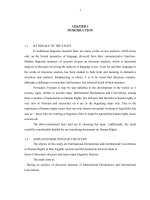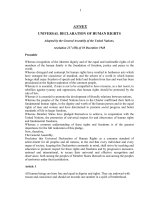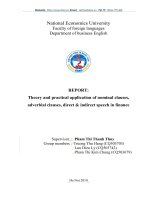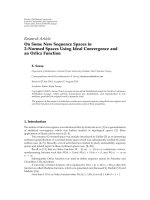Application of chitin, chitosan and some new food products in Korea
Bạn đang xem bản rút gọn của tài liệu. Xem và tải ngay bản đầy đủ của tài liệu tại đây (1.4 MB, 38 trang )
Application of chitin, chitosan and
some new food products in Korea
Professor Hur, Jong Wha
Food Engineering Lab
Dept. of Food Science and
Technology
Gyeongsang National University, Korea
Introduction
1.1 Chitin and chitosan
Chitin is a complex molecular, a polysaccharide, can be
found in crabs, lobster, shrimp, worms, fungus…
Chitosan is a polymer derived from chitin by deacetylating
Fig 1: Chitin
Fig 2: Chitosan
1.2 Function of chitin and chitosan
Preservative
Food additive
Waste water treatment
Fermentation accelerator
Cosmetics
Diagnosis tester
Medicine
Application of
Chitin & Chitosan
1.3 Structure of application of chitin and chitosan in Korea
Fig 3: Structure of application of chitin and chitosan in Korea
Chitin and chitosan products on the world
5%
16%
25
31%
20
Value of chitosanproducts
(Billions USD)
48%
19.9
15
12.7
10
6.4
2.1
5
0
USA
USA Europe Japan Korea
Europe
Japan
Country, area
Fig 4: Market of chitin and chitosan products on the World
Korea
Producing chitosan
by chemical
1.4 Procedure of producing chitosan by chemical
Procedure 1
Chitosan
Material
↓
Size reduction(5~10mm)
↓
Washing
↓
Depigmentation (Ethanol treatment)
↓
Deproteination (1N KOH)
↓
Washing
↓
Demineralization (1N HCl)
↓
Washing
↓
Drying
↓
Deacetylation (55% KOH)
↓
Desalting and Washing
↓
Chitosan
Advantage and disadvantage of producing chitosan by chemical
Advantage
• Simple
• Low investment
Disadvantage
• Pollution
• High cost price product
Producing chitosan
by enzyme
1.5 Procedure of producing chitosan by enzyme
Procedure 2
Chitosan
Material
↓
Size reduction(5~10mm)
↓
Washing
↓
Depigmentationase
↓
Deproteinationase
↓
Demineralizationase
↓
Drying
↓
Deacetylationase
↓
Washing
↓
Chitosan
Enzyme kinetics
Fig 5: Enzyme velocity and [substrate]
Fig 6: [Product] and reaction time
Advantage and disadvantage of producing chitosan by enzyme
Advantage
• Good for environment
• Low cost price product
Disadvantage
• Require high technology
• High investment
Some applications of
chitosan in Food Industry
2.1 Application chitosan to acorn gel
Procedure 3
Soy
↓
Soaking
↓
Grinding
↓
Boiling
↓
Filtering
↓
Coagulating
↓
Dehydrating
↓
Shaping
↓
Packaging
↓
Acorn gel
Coagulating agent,
Chitosan
Results
The structure of acorn gels containing chitosan is
more fine and fibrous than the control.
Acorn gel without chitosan is contaminated by
fungi and deteriorated in 3 days. But acorn gel
containing chitosan is extended 6 days at room
temperature
The texture of acorn gel containing chitosan is
more hard, brittle and elasticity than the control.
Results
A
B
C
D
A. Control
B. 0.5% Chitosan solution added
C. 0.7% Chitosan solution added
D. 1.0% Chitosan solution added
Fig 7: Photomicrographs of acorn flour gels.
Results
A
B
C
D
A. Control
B. 0.5% Chitosan solution added
C. 0.7% Chitosan solution added
D. 1.0% Chitosan solution added
Fig 8: Scanning electronic micrographs of acorn gels.
Results
0
DAYS
3
6
A
B
A. Control
B. 0.5% Chitosan solution added
C. 0.7% Chitosan solution added
D. 1.0% Chitosan solution added
C
D
Fig 9: Preservative effects of chitosan solution on acorn flour gels.
2.2 Application chitosan to orange juice as food additives
Procedure 4
Orange
↓
Peeling
↓
Extracting
↓
Homogenizing
↓
Filtering
↓
Mixing
↓
Filtering
↓
Packaging
↓
Pasteurizing
↓
Orange juice sample
Chitosan
Results
Fig 10: Effects of chitosan treatments on the color of orange juice
A: Control, B,C,D,E,F : treated with each 0.5g, 1.0g, 2.0g, 3.0g, 4.0g, of 1%
chitosan in 2% ascorbic acid solution/100g sample, respectively.
Ingredient
2.3 Chitosan ice cream
Procedure 5
Material
Mixing
Pasteurizing
Cooling
Freezing
Packaging
Hardening
Storage
Products
Skim milk
Raw milk
Cream
Corn syrup
Glucose
Sugar
Stabilizer
Emulsifier
Chitosan
Water
% in mixture
8.0
10.0
28.0
3.0
4.3
10.8
0.5
0.38
0.02
35.0
Product characteristics
Compare with normal ice cream
Higher viscosity
High heat shock
Higher microbiology stability
Lower price
Higher sensory quality
Preventing obesity
2.4 Application chitosan to vinegar as food additives
Procedure 6
Persimmon vinegar
React
Vinegar sample
Chitosan








